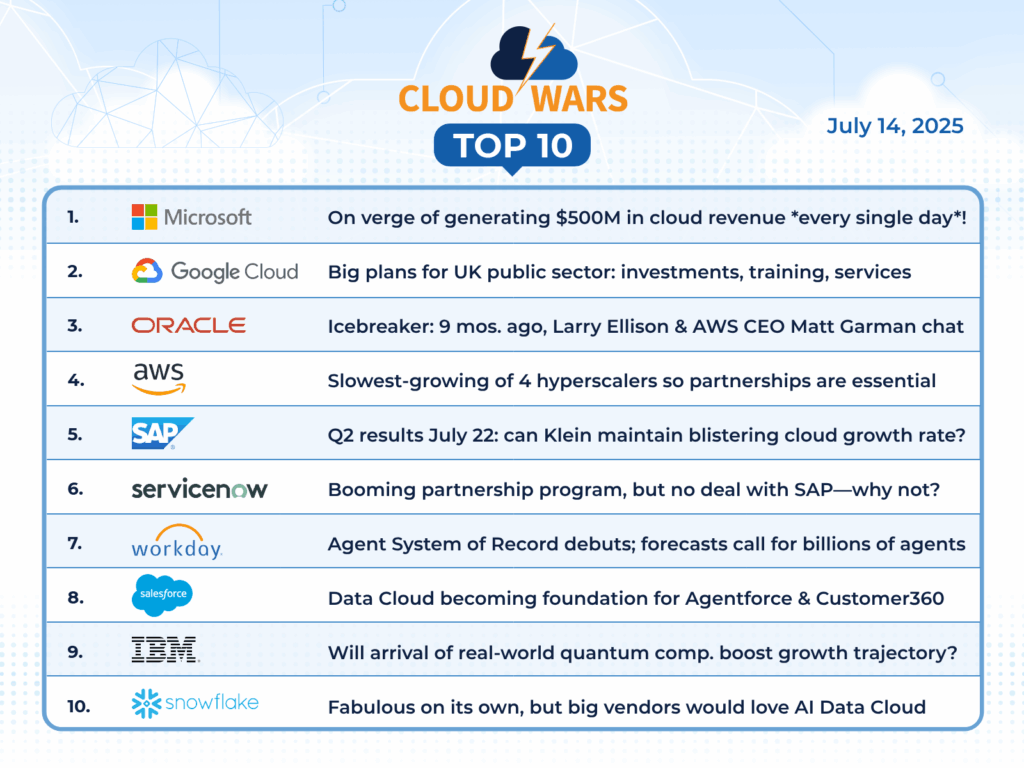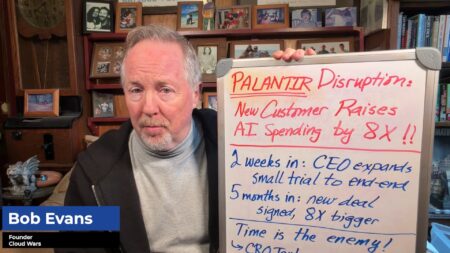
After several years of two-way competitive bombast, Oracle and AWS have begun delivering greatly enhanced business outcomes to their mutual customers thanks to the wildly popular Oracle Database@AWS multi-cloud partnership.
While I take a back seat to no one in my advocacy for the type of unfettered free-market competition that has made the Cloud Wars not only the greatest growth market the world has ever known but also the greatest forge of technological innovation in human history, we also need to bear in mind that there is, as the metaphysical philosopher Yogi Berra once said, “a time to reap and a time to sow.”
Right now, there’s a whole lotta reaping going on for Oracle and AWS as the landmark multi-cloud agreement they forged just nine months ago begins to bear fruit in the form of hundreds of delighted customers who are finally, as a direct consequence of AWS and Oracle agreeing to work together, able to do things they’ve dreamed about for many years.
And because the two companies reached a major milestone last week, many more customers will soon be realizing those critical business benefits as well (a list of 10 key examples is coming in a moment).
With Oracle Database@AWS now generally available, “Customers can now run Oracle Exadata Database Service and Oracle Autonomous Database on dedicated infrastructure on Oracle Cloud Infrastructure (OCI) within AWS,” the companies announced last week.
The service is currently available in AWS’s U.S. East and U.S West regions, and the companies are racing to expand it into 20 additional regions across the globe. The companies did not release the locations of those 20 additional regions, nor did they say when the Oracle Database@AWS service would go live in them.
For customers, the big benefits are less integration, more choices for deployment, less low-value data preparation, faster time to value, simplified operations and outcomes.
In an email reply to a couple of my questions, Oracle Vice-President for OCI Multicloud Kambiz Aghili said, “By unifying data architecture, governance, security, and services across Oracle and AWS, customers can break down data siloes and use all of their business data to generate deeper insights and develop new innovations using AWS analytics, machine learning, and generative AI services.”
Asked to name some of the more-popular ways customers are using the service, Aghili responded, “For example, a financial-services company could now seamlessly combine near real-time transactional data from Oracle databases with customer interaction data in AWS to create comprehensive fraud-detection dashboards that identify suspicious patterns. Unified data architecture and natively interoperable services across both cloud providers were not possible before this partnership, and now customers can build new multi-cloud applications and look for patterns across all their data within seconds.”

AI Agent & Copilot Summit is an AI-first event to define opportunities, impact, and outcomes with Microsoft Copilot and agents. Building on its 2025 success, the 2026 event takes place March 17-19 in San Diego. Get more details.
Another example offered by Aghili involved the ability for retailers to “leverage zero-ETL integration to automatically feed product-inventory data between Oracle databases and AWS services, where it’s immediately available for machine learning models that dynamically optimize pricing strategies and generate personalized customer recommendations without complex data-pipeline management.”
In addition to strong customer demand from financial-services and retail companies, Aghili also cited healthcare, manufacturing, telecommunications, and utilities as other industries in which adoption has been strong.
Some of the early customers identified by Aghili are State Street, Best Buy, Vodafone, Fidelity Investments, Nationwide, and SAS.
From the information shared by Oracle and AWS about the general-availability milestone, I pulled out these 10 distinct advantages for customers:
1. Customers have more choice about which workloads to deploy in which clouds, and that’s becoming for many customers an inalienable right.
2. AWS customers can now migrate their Oracle Databases to the cloud more rapidly, more securely, and less expensively.
3. AWS customers can more simply integrate data between Oracle Database services and AWS analytics services, which eliminates the need for customers to build costly and complex data pipelines.
4. That data integration also helps AWS customers enhance their applications by giving them direct access to AWS’s ML and GenAI technologies and services.
5. AWS customers don’t need to re-architect their apps to use the new service, which means lower costs, faster time to value, and happier developers.
6. Customers can now have a single and unified experience across both clouds.
7. Customers gain fully integrated and consistent support from both vendors rather than having to constantly try to figure out which company to call and how to get problems fixed rapidly and completely.
8. For AWS customers, the entire process of procuring, deploying, and administering their Oracle Databases is simplified.
9. The service is fully set up on the AWS Marketplace, which is becoming a key procurement source for many customers.
10. AWS customers gain full access to Oracle’s RAC technology and its latest database purpose-built for AI, Oracle Database 23ai.
Final Thought
Now, if all this lovey-dovey stuff sounds a little dubious in light of the long and highly combative history AWS and Oracle have had, that’s perfectly understandable. In fact, I think we can expect those two wildly successful companies to compete vigorously and broadly in the Cloud Wars, particularly as the AI Revolution kicks into high gear.
But the big breakthrough is that Oracle and AWS have clearly learned via this Oracle Database@AWS experience that while there’s a time to lay down arms and collaborate peacefully, there’s also plenty of time for some traditional bare-knuckle competition of the type that ensures that the biggest winners in the Cloud Wars are always — always! — the customers.











